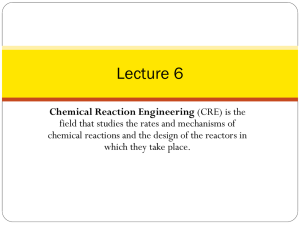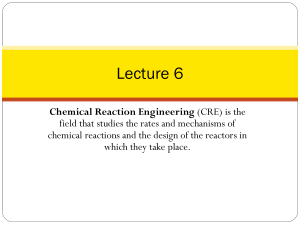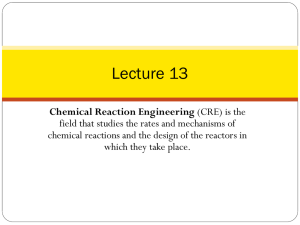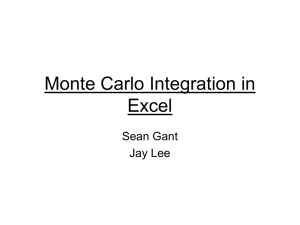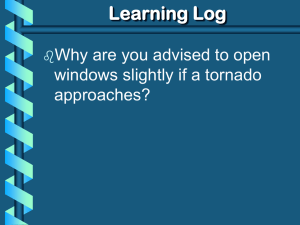Animated PowerPoint
advertisement
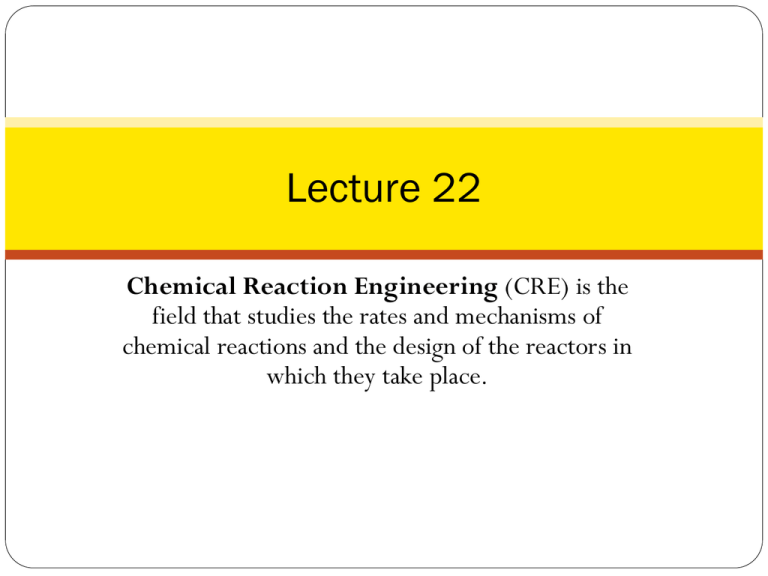
Lecture 22 Chemical Reaction Engineering (CRE) is the field that studies the rates and mechanisms of chemical reactions and the design of the reactors in which they take place. Web Lecture 22 Class Lecture 18-Thursday 3/21/2013 Multiple Reactions with Heat Effects 2 Multiple Reactions with Heat Effects PFR/PBR: dT dV UaTa T rij H Rxij n i 1 m F C j 1 j Pj CSTR: UATa T FA0 CPi i T T0 rij H Rxij T 0 3 m q j1 i 1 These equations are coupled with the mole balances and rate law equations. Multiple Reactions with Heat Effects Multiple Reactions Make sure it is in respect to A; Subscripts must agree dT Q g Q r dV Fi C Pi 4 Q g rijH Rxij r1A H Rx1A r2A H Rx 2A Multiple Reactions with Heat Effects Multiple Reactions 1) Mole Balances:– every species (no conversion!) 2) Rate Laws: – relative rates – net rates 3) Stoichiometry: 5 CA CT 0 FA T0 y FT T dy FT T dW 2 y FT 0 T0 Multiple Reactions with Heat Effects Multiple Reactions 4) Heat Effects: dT Q g Q r dV Fi C Pi Q g heat produced Q r heat removed Q g rij H Rxij Q r Ua(T - Ta ) 6 (must havematchingi, j) Multiple Reactions with Heat Effects 4) Heat Effects: dT Q g Q r dV Fi C Pi Q g r1A H R1A r2 A H R 2 A Q r Ua T Ta FC i Pi FA C PA FB C PB FC C PC FD C PD dTa Ua T Ta i C Pcool dV m 5) Parameters 7 E1 , E 2 , FA0 , Ua, ...etc Multiple Reactions with Heat Effects 4) Heat Effects: dT Qg Qr dV Fi C Pi 23 H Rx1 A 12kJ /(mole of A reacted in reaction 1) H Rx 2 B 8kJ /(mole of B reacted in reaction 2) Qg r1 A H Rx1 A r2 B H Rx 2 B Use relative rates of reaction to get r2B in terms of the rate law that is given for reaction 2, e.g. , 8 -r (2) 2A k 3 A 2B - - 2D 3 2A C C A B then r2B 2 r2A 3 The complex gas phase reactions (1) A 2B C r1A k 1ACAC2B H Rx1B 15,000 cal mol B (2) A C 2D r2C k 2C CACC H Rx 2A 10,000 cal mol A take place in a 10 dm3 PFR with a heat exchanger. Plot the temperature, concentrations, molar flow rates down the length of the reactor for the following operations. E.g., Note any maximums minimums on your plot along with how they change for the different types of operations. or (a) Adiabatic operation (b) Heat exchange with constant Ta (c) Co current heat exchange (d) Counter current heat exchange (e) For parts (c) and (d), plot Qr and Qg down the length of the reactor. What do you observe? Additional Information C PA 10 cal mol K C PC 30 cal mol K C PB 10 cal mol K C PD 20 cal mol K s K at 300K and E 1 8,000 cal mol 2 k 2C 2 dm 3 mol s K at 300K and E 2 12,000 cal mol k 1A 40 dm 3 mol C T 0 0.2 mol dm 3 9 2 , C PCool 1cal g K ÝCool 20g s , m Ua 80 cal dm 3 s K , Tao 325K , T0 300K FA0 5 mol s , FB0 10 mol s , FC0 0 , FD0 0 10 11 12 13 Multiple Reactions with Heat Effects Multiple Reactions 4) Heat Effects: UaT Ta dT rA H Rx dV FiCPi dT Qg Qr dV Fi C Pi Qg rij H Rij 14 Qg heat produced Qr heat removed (must have matching i, j) Multiple Reactions with Heat Effects in a PFR and CSTR Examples: (1) A 2B C r1A k1A CA CB2 and H R1A 20,000 cal mol A (2) 2A 3C D r2C k2C CA2 CC3 and 15 H R 2A 10,000 cal mol A Example A: Liquid Phase CSTR (1) A 2 B C r1A k1A CA CB2 NOTE: The specific reaction rate k1A is defined with respect to species A. (2) 3C 2 A D r2C k2C C C 3 C 2 A NOTE: The specific reaction rate k2C is defined with respect to species C. 16 Example A: Liquid Phase CSTR The complex liquid phase reactions take place in a 2,500 dm3 CSTR. The feed is equal molar in A and B with FA0=200 mol/min, the volumetric flow rate is 100 dm3/min and the reation volume is 50 dm3. Find the concentrations of A, B, C and D existing in the reactor along with the existing selectivity. Plot FA, FB, FC, FD and SC/D as a function of V 17 Example A: Liquid Phase CSTR Solution Liquid Phase CSTR 1) Mole Balances: (1) f CA 0CA 0 0CA rAV (2) f CB 0CB 0 0CB rBV (3) f CC 0CC rCV (4) f CD 0CD rDV 18 2) Net Rates: (5) rA r1A r2A Example A: Liquid Phase CSTR 3) Stoichiometry: (16) CA FA 0 (17) CB FB 0 (18) CC FC 0 (19) CD FD 0 4) Parameters: 19 (20) 0 100dm3 min (21) k1A 10 dm mol min (22) 3 15 dm 3 k 2C mol 2 4 min Example B: Liquid Phase PFR Takes place in a PFR. The feed is equal molar in A and B and FA0=200 mol/min and the volumetric flow rate is 100 dm3/min. The reaction volume is 50 dm3 and the rate constants are: k1A 10 dm mol min 3 2 k2C 15 dm mol min 3 4 Rate laws are the same as Example A. Plot FA, FB, FC, FD and SC/D as a function of V. 20 Example B: Liquid Phase PFR 1) Mole Balances: 21 Example B: Liquid Phase PFR 2) Net Rates: (5) (6) (7) (8) rA r1A r2A rB r1B rC r1C r2C rD r2D 2) Rate Laws: 2 r1A k1A CA CB (9) 22 (10) r2C k2C C C 2 A 3 C Example B: Liquid Phase PFR 2) Relative Rates: r1A r1B r1C 1 2 1 (11) (12) r1B 2r1A r1C r1A r2A r2C r2D 2 3 1 23 (13) r2A 2 3r2C (14) r2D 1 3r2C Reaction 1 Reaction 2 Example B: Liquid Phase PFR 2) Rate Laws: r1 A k1 AC AC B2 r2C k 2C C A2 CC3 rA r1 A r2 B rC r1C r2C r1C r1 A r2 A 2 / 3r2C 24 5 k1 A k1 A1 expE1 R 1 T1 1 T 6 7 k 2C k 2C 2 expE2 R 1 T2 1 T 8 9 rB r1B 10 11 rD r2 D 12 13 r1B 2r1 A 13 15 r2 D 1 / 3r2C 16 Example B: Liquid Phase PFR 3) Stoichiometry: C A CT 0 FA T0 y FT T 17 CC CT 0 FC T0 y FT T 19 FT FA FB FC FD 25 21 C B CT 0 FB T0 y FT T 18 C D CT 0 FD T0 y FT T 20 dy FT T dV 2 y FT 0 T0 22 Multiple Reactions with Heat Effects 4) Heat Effects: Qg Qr dT dV Fi C Pi dTa UaT Ta i C Pcool dV m 23 26 24 25 Qr UaT Ta CP FACPA FBCPB FC CPC FDCPD 27 Qg r1 A H R1 A r2 A H R 2 A Parameters: 26 E1 , E2 , FA0 ,.... Selectivity If one were to write SC/D=FC/FD in the Polymath program, Polymath would not execute because at V=0, FC=0 resulting in an undefined volume (infinity) at V=0. To get around this problem we start the calculation 10-4 dm3 from the reactor entrance where FD will not be zero and use the following IF statement. (15) 27 S˜C D FC if V 0.001 then else 0 FD Selectivity 3) Stoichiometry: (16) CA FA 0 (17) CB FB 0 (18) CC FC 0 (19) CD FD 0 Parameters: 28 (20) 0 100dm3 min (21) k1A 10 dm3 mol min (22) k 2C 15 dm mol 2 3 4 min End of Web Lecture 22 Class Lecture 18 29
